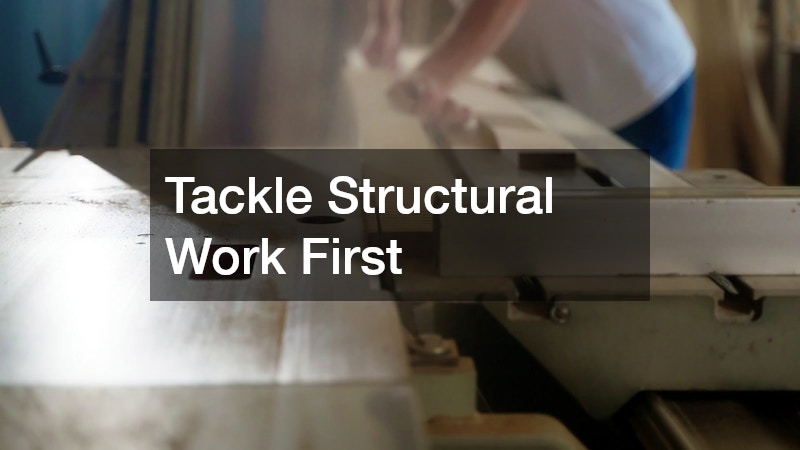Remodeling your home can completely transform how you live. From updating old spaces to improving comfort, every detail matters. But to do it right, you need more than just good ideas — you need a plan that balances creativity, practicality, and safety.
This guide walks you through the essentials of successful home remodeling — from planning and budgeting to working with contractors and maintaining your new space.
1. Start with a Clear Plan

Every successful remodel begins with a solid plan. Before any demolition or design work starts, take time to map out your goals, timeline, and budget. A well-thought-out plan prevents confusion, delays, and expensive mistakes as the project progresses.
Start by listing what you want to update, repair, or completely transform. Identify must-have features versus nice-to-have additions — this helps prioritise spending and manage expectations. If possible, use design tools or apps to visualise layouts and explore different material options.
Don’t forget to assess your home’s hidden systems early on. Check for plumbing leaks, outdated wiring, or foundation concerns before work begins. For example, if you notice drainage issues or slow water flow, it’s smart to schedule a sewer line repair ahead of construction. Addressing these behind-the-scenes issues now ensures your remodel is built on a safe, reliable foundation — saving time, money, and stress later.
2. Set a Realistic Budget
Budgeting is one of the most crucial steps in any home remodeling project. Without a well-defined financial plan, even the smallest renovation can quickly spiral out of control. Start by identifying your total spending limit, then divide it into clear categories — materials, labor, permits, design fees, and inspections. It’s also smart to include a contingency fund of about 10–15% to cover unexpected costs, such as hidden water damage or last-minute upgrades.
Take time to gather multiple estimates from contractors before making a final decision. Comparing quotes not only helps you find fair pricing but also gives you insight into the quality and professionalism of each company. Don’t automatically go with the lowest bid — consider value, reliability, and experience.
Lastly, don’t overlook the cost of waste management. Remodeling produces plenty of debris, so make sure to budget for garbage pickup or dumpster rentals. Many local councils have specific guidelines for disposal, so setting aside funds for proper cleanup keeps your project organized, environmentally responsible, and compliant with local regulations. A thoughtful budget is your roadmap to a smooth, stress-free remodeling experience.
3. Protect Your Home and Family
Once construction starts, your home effectively turns into a work zone — and safety becomes the top priority. Protecting your family, pets, and property from hazards helps ensure a smooth remodeling process with fewer risks or delays.
Start by sealing off construction zones using plastic sheeting or temporary barriers. This prevents dust, debris, and fumes from spreading into living areas. Cover floors, furniture, and vents to minimise damage and make post-construction cleaning easier. Keep children and pets away from active workspaces to avoid accidents and interruptions.
Another often-overlooked precaution is pest control. Open walls, exposed foundations, and piles of building materials can quickly attract insects and rodents. Scheduling preventive pest control before and during the remodel ensures you won’t face infestations once the project is complete.
A clean, contained, and well-protected environment keeps your home safe throughout construction — preserving comfort and peace of mind until your renovation is finished.
4. Hire Experienced Professionals
Even if you’re confident in your DIY skills, large-scale remodeling projects often require the expertise of trained professionals. Hiring the right people can save you time, money, and frustration while ensuring the work is done safely and correctly. Skilled professionals understand building codes, handle permits, and know how to prevent costly mistakes that can arise from inexperience.
When selecting contractors, always look for proper licensing, insurance, and strong references from previous clients. Check online reviews and ask for a portfolio of past work to gauge their quality and reliability. Clear communication is key — the best professionals provide detailed, itemized estimates, establish realistic timelines, and keep you informed every step of the way.
Partnering with a reputable construction company also gives you access to a network of specialists, including electricians, plumbers, and designers, who can collaborate efficiently under one roof. This coordination helps maintain consistent quality, prevents scheduling conflicts, and ensures that every part of your remodel aligns with your vision. Choosing experienced experts is an investment in your home’s long-term safety, value, and beauty.
5. Tackle Structural Work First

Before getting into design choices like paint colors or flooring, it’s essential to start with the structural foundation of your remodel. Any work that affects the integrity of your home — such as removing walls, reinforcing beams, or expanding rooms — must be handled carefully and professionally. Addressing structural components early prevents costly rework later and ensures that your remodel remains safe and compliant with building codes.
This phase often involves heavy machinery, precise measurements, and proper load management, which is why it’s best left to experienced contractors. A well-planned demolition allows old or damaged materials to be removed safely, making room for new construction without harming the sections that will remain. Professional crews also know how to contain dust, manage waste, and dispose of debris responsibly.
Before any structural work begins, double-check that your contractor has secured the appropriate permits and approvals from local authorities. These documents protect you legally and confirm that all work meets safety regulations. Taking the time to do this part right lays the groundwork for a smooth, stable, and successful remodeling project.
6. Upgrade Key Systems and Surfaces
Before focusing on the visual aspects of remodeling, it’s crucial to prioritise your home’s essential systems — the roof, foundation, plumbing, and electrical work. These components form the structural and functional backbone of your home. Neglecting them during renovations may lead to costly problems down the road, such as leaks, wiring issues, or uneven flooring. By addressing these systems early, you ensure that your remodel remains safe, efficient, and long-lasting.
If your plans include a roof replacement, evaluate whether your home’s architecture and climate make flat roofing a good fit. This contemporary option offers a sleek, modern profile and can provide additional usable space, such as a rooftop garden or solar installation area. However, it requires professional installation and proper drainage to prevent water pooling or leaks.
While walls and floors are open, take advantage of the opportunity to upgrade outdated wiring, plumbing, and insulation. It’s far easier and more affordable to complete these improvements now rather than after the finishing touches are in place. Modernizing these systems boosts energy efficiency, enhances comfort, and adds long-term value to your home.
7. Keep the Worksite Organized
An organized worksite is key to maintaining safety, efficiency, and professionalism throughout your remodeling project. Cluttered or messy areas can slow progress, create hazards, and make it difficult for workers to perform their jobs effectively. Keeping the site clean and structured not only improves workflow but also leaves a positive impression on neighbors, inspectors, and potential buyers if you ever decide to sell your home.
One of the best ways to maintain order is by arranging proper waste management from the start. Hiring a local waste removal service or renting a small dumpster ensures that debris like drywall, wood, and tiles are disposed of promptly and responsibly. This helps prevent injuries, fire risks, and environmental violations from improper dumping.
Ask your contractor to implement daily cleanup routines and clearly mark walkways, storage areas, and delivery zones. Regularly removing clutter and organizing materials minimizes delays, protects equipment, and keeps everyone on the same page. A tidy workspace not only boosts productivity but also creates a safer environment for workers and your family alike.
8. Manage the Small Stuff Efficiently
While major remodeling work requires specialized contractors, many smaller finishing tasks can be handled by a skilled handyman. These professionals are ideal for taking care of minor but important details that complete your renovation — from installing shelving and fixing drywall to mounting fixtures and adjusting doors. Their flexibility and wide skill set make them an invaluable resource during the final stages of a remodel, when precision and timing are everything.
Hiring a handyman can also save you money and reduce delays. Instead of calling multiple specialists for small, scattered jobs, a single reliable handyman can manage a variety of tasks efficiently. This ensures consistency in quality and helps you wrap up the project faster.
When choosing one, always check their credentials, online reviews, and past work experience. Ask about their hourly rates and availability to ensure they fit your schedule and budget. A dependable handyman bridges the gap between large-scale construction work and the finishing touches that make your remodeled home truly feel complete.
9. Enhance Curb Appeal
Your home’s exterior is the first thing people notice, so investing in its appearance can make a big difference in overall value and impression. Enhancing curb appeal doesn’t just make your property look more inviting — it also reflects the care and quality inside your home. Simple upgrades like repainting trim, adding outdoor lighting, and updating the landscaping can completely transform how your home is perceived.
Driveways, walkways, and patios also play a major role in exterior appeal and functionality. Hiring a professional paving service to resurface or replace worn-out concrete and asphalt can greatly improve both safety and aesthetics. High-quality paving provides better drainage, reduces tripping hazards, and gives your home a smooth, polished look that ties the entire design together.
To create a harmonious feel, coordinate your exterior color palette and materials with the interior design of your remodel. Matching tones, textures, and finishes helps achieve a seamless flow from indoors to outdoors. Whether you’re preparing to sell or simply upgrading for your own enjoyment, enhancing curb appeal is one of the smartest finishing touches you can make.
10. Complete the Transformation Outdoors
A home renovation doesn’t end at the walls — your outdoor space plays an equally important role in the overall transformation. A thoughtfully designed yard or garden extends your living area, offering a relaxing escape or a welcoming spot for entertaining. Whether you prefer a lush, green retreat or a minimalist modern setup, aligning your outdoor design with your home’s refreshed interior makes the entire property feel cohesive and complete.
Hiring a landscaping contractor can help bring your vision to life efficiently and professionally. They can design and install essential features like irrigation systems, garden beds, accent lighting, and retaining walls to balance beauty with function. Proper landscaping also improves drainage, prevents soil erosion, and enhances curb appeal — making your home stand out for all the right reasons.
Beyond aesthetics, landscaping offers practical benefits. Strategically placed trees and shrubs can reduce energy costs by providing shade and natural insulation, keeping your home cooler in summer and warmer in winter. Completing your remodel with a stunning outdoor transformation ensures every corner of your property reflects your style, comfort, and attention to detail.
Bringing It All Together
Home remodeling is a journey that combines imagination, planning, and teamwork. It’s about creating a home that fits your lifestyle while improving comfort and efficiency.
To do it the right way:
-
Start with a solid plan and realistic budget.
-
Address structural and safety concerns first.
-
Work with licensed professionals.
-
Keep the project clean and organized.
-
Finish strong with thoughtful design and landscaping.
Whether you’re fixing plumbing, improving roofing, or giving your backyard a fresh look, every step plays a role in the final result. From scheduling a sewer line repair to coordinating local waste removal, success comes from careful attention to detail and smart decision-making.
When done right, remodeling doesn’t just upgrade your house — it reinvents the way you live in it.
